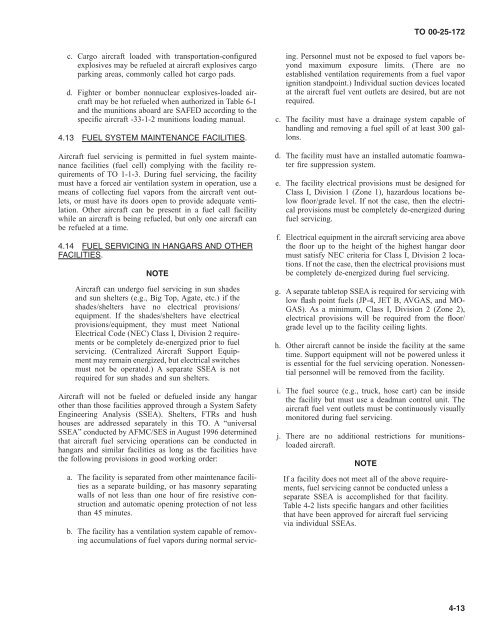TO 00-25-172 - Robins Air Force Base
TO 00-25-172 - Robins Air Force Base
TO 00-25-172 - Robins Air Force Base
Create successful ePaper yourself
Turn your PDF publications into a flip-book with our unique Google optimized e-Paper software.
<strong>TO</strong> <strong>00</strong>-<strong>25</strong>-<strong>172</strong><br />
c. Cargo aircraft loaded with transportation-configured<br />
explosives may be refueled at aircraft explosives cargo<br />
parking areas, commonly called hot cargo pads.<br />
d. Fighter or bomber nonnuclear explosives-loaded aircraft<br />
may be hot refueled when authorized in Table 6-1<br />
and the munitions aboard are SAFED according to the<br />
specific aircraft -33-1-2 munitions loading manual.<br />
4.13 FUEL SYSTEM MAINTENANCE FACILITIES.<br />
<strong>Air</strong>craft fuel servicing is permitted in fuel system maintenance<br />
facilities (fuel cell) complying with the facility requirements<br />
of <strong>TO</strong> 1-1-3. During fuel servicing, the facility<br />
must have a forced air ventilation system in operation, use a<br />
means of collecting fuel vapors from the aircraft vent outlets,<br />
or must have its doors open to provide adequate ventilation.<br />
Other aircraft can be present in a fuel call facility<br />
while an aircraft is being refueled, but only one aircraft can<br />
be refueled at a time.<br />
4.14 FUEL SERVICING IN HANGARS AND OTHER<br />
FACILITIES.<br />
NOTE<br />
<strong>Air</strong>craft can undergo fuel servicing in sun shades<br />
and sun shelters (e.g., Big Top, Agate, etc.) if the<br />
shades/shelters have no electrical provisions/<br />
equipment. If the shades/shelters have electrical<br />
provisions/equipment, they must meet National<br />
Electrical Code (NEC) Class I, Division 2 requirements<br />
or be completely de-energized prior to fuel<br />
servicing. (Centralized <strong>Air</strong>craft Support Equipment<br />
may remain energized, but electrical switches<br />
must not be operated.) A separate SSEA is not<br />
required for sun shades and sun shelters.<br />
<strong>Air</strong>craft will not be fueled or defueled inside any hangar<br />
other than those facilities approved through a System Safety<br />
Engineering Analysis (SSEA). Shelters, FTRs and hush<br />
houses are addressed separately in this <strong>TO</strong>. A “universal<br />
SSEA” conducted by AFMC/SES in August 1996 determined<br />
that aircraft fuel servicing operations can be conducted in<br />
hangars and similar facilities as long as the facilities have<br />
the following provisions in good working order:<br />
a. The facility is separated from other maintenance facilities<br />
as a separate building, or has masonry separating<br />
walls of not less than one hour of fire resistive construction<br />
and automatic opening protection of not less<br />
than 45 minutes.<br />
b. The facility has a ventilation system capable of removing<br />
accumulations of fuel vapors during normal servicing.<br />
Personnel must not be exposed to fuel vapors beyond<br />
maximum exposure limits. (There are no<br />
established ventilation requirements from a fuel vapor<br />
ignition standpoint.) Individual suction devices located<br />
at the aircraft fuel vent outlets are desired, but are not<br />
required.<br />
c. The facility must have a drainage system capable of<br />
handling and removing a fuel spill of at least 3<strong>00</strong> gallons.<br />
d. The facility must have an installed automatic foamwater<br />
fire suppression system.<br />
e. The facility electrical provisions must be designed for<br />
Class I, Division 1 (Zone 1), hazardous locations below<br />
floor/grade level. If not the case, then the electrical<br />
provisions must be completely de-energized during<br />
fuel servicing.<br />
f. Electrical equipment in the aircraft servicing area above<br />
the floor up to the height of the highest hangar door<br />
must satisfy NEC criteria for Class I, Division 2 locations.<br />
If not the case, then the electrical provisions must<br />
be completely de-energized during fuel servicing.<br />
g. A separate tabletop SSEA is required for servicing with<br />
low flash point fuels (JP-4, JET B, AVGAS, and MO-<br />
GAS). As a minimum, Class I, Division 2 (Zone 2),<br />
electrical provisions will be required from the floor/<br />
grade level up to the facility ceiling lights.<br />
h. Other aircraft cannot be inside the facility at the same<br />
time. Support equipment will not be powered unless it<br />
is essential for the fuel servicing operation. Nonessential<br />
personnel will be removed from the facility.<br />
i. The fuel source (e.g., truck, hose cart) can be inside<br />
the facility but must use a deadman control unit. The<br />
aircraft fuel vent outlets must be continuously visually<br />
monitored during fuel servicing.<br />
j. There are no additional restrictions for munitionsloaded<br />
aircraft.<br />
NOTE<br />
If a facility does not meet all of the above requirements,<br />
fuel servicing cannot be conducted unless a<br />
separate SSEA is accomplished for that facility.<br />
Table 4-2 lists specific hangars and other facilities<br />
that have been approved for aircraft fuel servicing<br />
via individual SSEAs.<br />
4-13
















